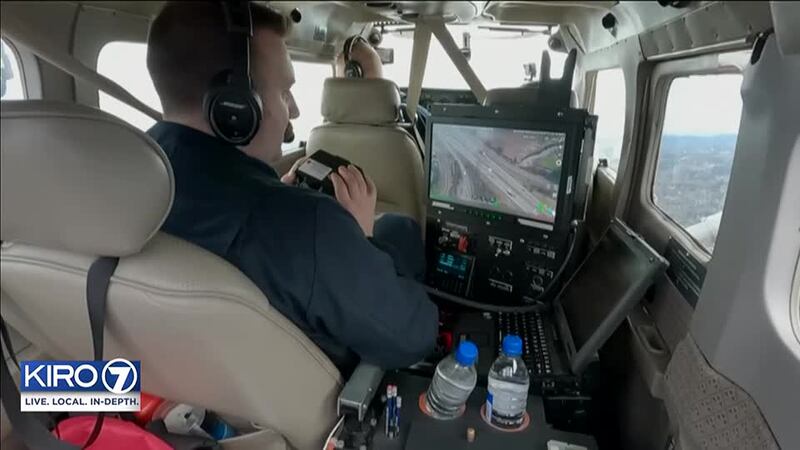This story was originally published February 11, 2024.
Deadly crashes on Western Washington roads are at their highest number in over 30 years and troopers say they are seeing more cases of aggressive driving.
The Washington State Patrol’s Aviation Unit, which works with troopers and other law enforcement on the ground, is preparing to expand its reach with a third plane equipped with HD and infrared lenses. The cameras allow troopers to track dangerous drivers in cases where patrol cars are not permitted to pursue.
KIRO 7’s Linzi Sheldon and photojournalist Jeff Ritter went up in the air with the WSP to see their detection and enforcement work in action.
“We’ve only been up in the air for a few minutes here and we already found a vehicle traveling 20 miles an hour over the posted speed limit,” Trooper Anson Statema said as they spotted a car going 80 miles an hour.
In the back, Trooper Nick Schureman can zoom in on vehicles and track their speed as Statema flies the plane.
Troopers also spotted a motorcycle popping wheelies on the highway, weaving, and splitting traffic. Schureman recorded his top speed at 145 miles an hour and helped troopers on the ground follow the motorcyclist safely and track him to a warehouse.
“We see a lot of… in the last two years, a lot of dangerous driving and drivers,” Statema said. “Really high rates of speed, aggressive driving. More frequent instances of people driving at speeds over 100 miles per hour.”
The Washington Traffic Safety Commission projects at least 800 people died on Washington roads in 2023, which would be the most since 1990. And it’s not counting injuries, like those suffered by Carl McNabb.
“Luck to be alive,” McNabb said from his hospital bed.
On January 4, McNabb was in the backseat of a blue and yellow taxi heading north on I-5 going home from the airport.
Prosecutors said Lauren Wickers, whom they describe as a repeat DUI offender, was going the wrong way on I-5 and slammed into McNabb’s taxi head-on.
“Just people [being] very cavalier... taking any risk they want to, basically,” McNabb said.
He’s recovering from injuries that include skull and facial fractures, compound fractures to both femurs, and four broken vertebrae.
“It is a significant problem,” Adam Eucker with the King County Prosecuting Attorney’s Office Felony Traffic Unit said. “We see the numbers continue to go up.”
They charged Wickers with vehicular assault, violation of her ignition interlock device, and reckless driving.
Eucker said they’re seeing more drivers using cannabis and alcohol and using them together.
“What we’re seeing is a lot of cases involving speed, a lot of cases involving impairment,” he said. “And those are two extremely dangerous things to have on our roadway.
Eucker said the KCPAO supports new traffic safety legislation being considered in the legislature right now, including lowering the BAC limit from 0.08 to 0.05. The move saw success in Utah when the state did the same in 2019. The National Highway Traffic Safety Administration found the state’s deadly crash rate dropped by nearly 20% in the first year under the lower legal limit.
KIRO 7 went through the Washington Traffic Safety Commission’s map of deadly crashes all around Western Washington over the last four years.
KIRO 7 spotted a cluster on Evergreen Way through Everett, along 99 and I-5 from downtown Seattle through North Seattle, and from Federal Way through Fife and Tacoma on I-5. The map shows crashes along all major highways.
“What do you tell people to do to protect themselves when they’re behind the wheel?” reporter Linzi Sheldon asked.
“Drive cautiously,” Trooper Statema said. “Leave yourself plenty of following distance.”
He urged people to put the phone down to reduce distractions and allow them to react quickly to a dangerous driver.
“Move over to a different lane if you need to,” he said. “Give them space. Don’t try to be the person that’s going to get in their way or slow them down.”
Once you’re out of their way, Statema said, call 911 from a hands-free device as soon as safely possible.
“People need to think about the others,” Carl McNabb said. “And the consequences... I just know there’s a long road ahead of me. And I could have easily been a goner.”
The WSP expects to get its third plane with this type of camera early next year and is asking for funding for a similar fourth plane in the current legislative session.
©2024 Cox Media Group








